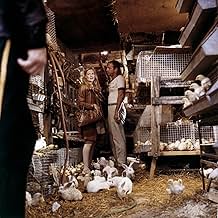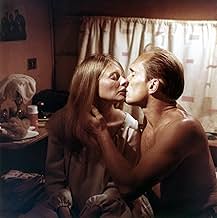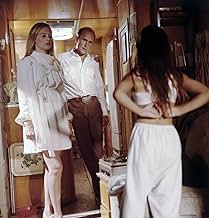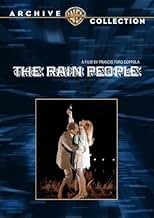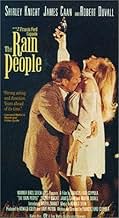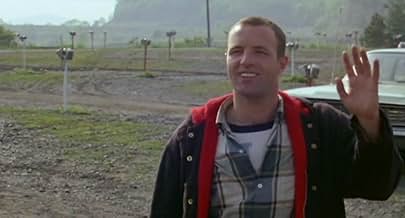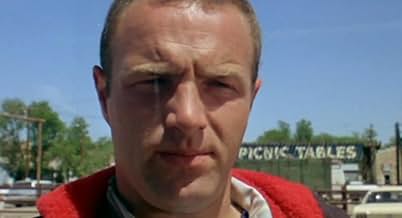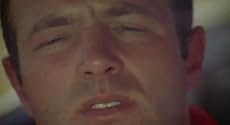VALUTAZIONE IMDb
6,8/10
4488
LA TUA VALUTAZIONE
Quando una casalinga scopre di essere incinta, corre fuori città in cerca di libertà per rivalutare le sue decisioni di vita.Quando una casalinga scopre di essere incinta, corre fuori città in cerca di libertà per rivalutare le sue decisioni di vita.Quando una casalinga scopre di essere incinta, corre fuori città in cerca di libertà per rivalutare le sue decisioni di vita.
- Premi
- 1 vittoria in totale
Laura Crews
- Ellen
- (as Laurie Crews)
Garrett Cassell
- Farmer
- (non citato nei titoli originali)
Eleanor Coppola
- Gordon's Wife
- (non citato nei titoli originali)
Recensioni in evidenza
This early Coppola work is overlong and erratic, but it is not devoid of praiseworthy qualities. The cinematography is excellent and the characters are memorable. James Caan is very convincing as the mentally handicapped hitchhiker. Also, because this film was shot on location all over the Eastern U.S., it offers an interesting, authentic look at America in the late 1960's. The title phrase does not have a significant meaning in the overall story, but only comes up during a conversation between the two lead characters (Caan and Shirley Knight). The way Coppola develops the characters by using short, dream-like flashbacks is very clever. In general, this film is not in the same class as Coppola's later work, but it's a solid character-driven story.
Francis Ford Coppola wrote and directed this stunningly personal story of a married woman's flight from her husband--and the reality that perhaps the youthful glee and excitement of her younger years are behind her. We learn little about this woman's marriage except that she has been feeling her independence slipping away as of late; she's also recently learned she's pregnant, which has further complicated her heart (she doesn't want to be a complacent wifey, despite the maternal way she speaks to her husband over the phone). She meets two men on her journey: a former college football hero who--after an accident during a game--has been left with permanent brain damage, and a sexy, strutting motorcycle cop who has a great deal of trouble in his own life. The clear, clean landscapes (as photographed by the very talented Wilmer Butler) are astutely realized, as are the characters. Shirley Knight, James Caan, and Robert Duvall each deliver strong, gripping performances, most especially since these are not very likable people in conventional terms. Some scenes (such as Knight's first call home from a pay-phone, or her first night alone with Caan where they play 'Simon Says') are almost too intimate to watch. Coppola toys with reality, turning the jagged memories of his characters into scrapbooks we've been made privy to. He allows scenes to play out, yet the editing is quite nimble and the film is never allowed to get too heavy (there are at least two or three very frisky moments). It's a heady endeavor--so much so that the picture was still being shown at festivals nearly five years later. Some may shun Coppola's unapologetic twisting of events in order to underline the finale with bitter irony, however the forcefulness and drive behind the picture nearly obliterate its shortcomings. *** from ****
Five years earlier and I doubt the movie could have found a distributor. It's slow, contemplative, and nothing much happens until the end. But for those who follow inner conflict as well as outer, it's a stunner. Pregnant suburban wife Knight hits the road, fleeing a consuming marriage. But she's not just fleeing, she's also aimlessly searching—note how she first bypasses Caan before hazily backing up. Trouble is Caan's brain damaged, and in need of adult supervision. Now Knight's in a pickle. On one hand, her budding maternal instinct kicks in; on the other, a grown child is too much what she's fleeing from. Thus, the confusion of her life mounts. But hey, she meets macho cop Duvall who's got adventure written all over him. Yet he turns out to be domineering and mean, probably too much like the husband she's abandoned. This leads up to an ending that is both touching and ironic.
For expansive post-war couples the suburbs were liberating; but a generation later and younger folks like Knight felt confined. This is a 60's road picture feminine style. When Americans get restless or unhappy, they head westward in frontier tradition. So why shouldn't a woman, even when alone and vulnerable. The acting here is outstanding, and it better be since character carries the story or what there is of it. I really like Caan who shows why less is sometimes more. And get a load of those desolate roadsides, no cosmetic Hollywood here. Too bad the film's so obscure in the Coppola canon. All in all, it's a telling reflection of a restless time, perhaps even of what some call the human condition. However, I can understand why it's not everyone's cup of tea, and certainly a long way from Coppola's next, The Godfather (1972).
For expansive post-war couples the suburbs were liberating; but a generation later and younger folks like Knight felt confined. This is a 60's road picture feminine style. When Americans get restless or unhappy, they head westward in frontier tradition. So why shouldn't a woman, even when alone and vulnerable. The acting here is outstanding, and it better be since character carries the story or what there is of it. I really like Caan who shows why less is sometimes more. And get a load of those desolate roadsides, no cosmetic Hollywood here. Too bad the film's so obscure in the Coppola canon. All in all, it's a telling reflection of a restless time, perhaps even of what some call the human condition. However, I can understand why it's not everyone's cup of tea, and certainly a long way from Coppola's next, The Godfather (1972).
Early Coppola with sublime cast that most folks never got to see (a pity). There's some wonderful things going on in this one - Shirley Knight's best performance (an underrated actress), a road trip in the late 1960's, James Caan very restrained and moving, Robert Duvall in a part he was born to play (edgy, lonely, motorcycle cop), and a touching script with F. Coppola behind the wheel.
If this had been made five years LATER by some nobody, it would have been a smash (so much for timing). Anyway, I recommend this to all people who don't need outer-space explosions and bad mother-in-law jokes or a billion dollar budget to sit for a few hours and watch a story unfold. Give this one a chance if you can find it!
If this had been made five years LATER by some nobody, it would have been a smash (so much for timing). Anyway, I recommend this to all people who don't need outer-space explosions and bad mother-in-law jokes or a billion dollar budget to sit for a few hours and watch a story unfold. Give this one a chance if you can find it!
A 30-ish wife on Long Island (Shirley Knight) needs to just get away and so enters her station wagon and drives west. To where? She doesn't know, but she picks up an ex-college football player (James Caan) before meeting a motorcycle cop (Robert Duvall).
"The Rain People" (1969) was made three years before Francis Ford Coppola became famous with "The Godfather." It was his first movie in which he had total creative control, writing and directing on the road without producers breathing down his neck. The story was inspired by Francis' mother curiously leaving home for a few days when he was a kid. It's about a woman's haphazard search for freedom from the manacles of domestic life. Unlike the domineering male protagonists of "Patton" (which he wrote), the Corleone patriarchs and Kurtz in "Apocalypse Now," Coppola shows us here several females manipulating men: Natalie with Kilgannon, Gordon and even Vinny; Ellen with Kilgannon and her father; and Rosalie with her dad.
Interestingly, it's the express opposite of Francis' previous movie, the fun "Finian's Rainbow," which was based on the 1947 Broadway hit. One is an energetic musical with a large cast while this has an everyday, depressing tone, made with a small cast & crew. While neither were successful at the box office, they both went on to garner cult followings after Coppola's great success in the 1970s-90s (of course he had a few movies that didn't do so well, but what else is new?).
I can see where many viewers would find "The Rain People" dull, but it features a daring premise and has historical significance, not to mention some notable cast members. Plus, it's a quality period piece for the late '60s. In regards to the commendable premise, Natalie loves her husband, but is uncertain about the responsibility of having his child and so instinctively flees the scene. Ironically, Killgannon becomes her surrogate 'child' on her road odyssey wherein she struggles with her obligations.
Concerning the 'historical significance,' the industry proudly cites "Stand Up and Be Counted" as the first flick to address women's liberation, which it overtly does. But this came out three years prior and few people noticed at the time because it's so covert. It was ahead of its time.
Francis originally intended to include a scene at the end to clear up what Natalie decides to do from there, but it wasn't needed because everything is explained in her monologue. Listen.
It runs 1 hour, 41 minutes, and was shot over the course of five months in several American states with a 10-person crew (along with a smattering of locals). The locations include: Garden City (opening shot), Manhattan (Lincoln Tunnel) & Hofstra University, New York; the Pennsylvania Interstate; Harrisonburg, Virginia (restaurant scene); Clarksburg (the drive-in theater) & Weston, West Virginia; Chattanooga, Tennessee (the parade); Brule (the burning house) & Ogallala (the reptile ranch), Nebraska; and other places for exterior shots.
GRADE: B/B-
"The Rain People" (1969) was made three years before Francis Ford Coppola became famous with "The Godfather." It was his first movie in which he had total creative control, writing and directing on the road without producers breathing down his neck. The story was inspired by Francis' mother curiously leaving home for a few days when he was a kid. It's about a woman's haphazard search for freedom from the manacles of domestic life. Unlike the domineering male protagonists of "Patton" (which he wrote), the Corleone patriarchs and Kurtz in "Apocalypse Now," Coppola shows us here several females manipulating men: Natalie with Kilgannon, Gordon and even Vinny; Ellen with Kilgannon and her father; and Rosalie with her dad.
Interestingly, it's the express opposite of Francis' previous movie, the fun "Finian's Rainbow," which was based on the 1947 Broadway hit. One is an energetic musical with a large cast while this has an everyday, depressing tone, made with a small cast & crew. While neither were successful at the box office, they both went on to garner cult followings after Coppola's great success in the 1970s-90s (of course he had a few movies that didn't do so well, but what else is new?).
I can see where many viewers would find "The Rain People" dull, but it features a daring premise and has historical significance, not to mention some notable cast members. Plus, it's a quality period piece for the late '60s. In regards to the commendable premise, Natalie loves her husband, but is uncertain about the responsibility of having his child and so instinctively flees the scene. Ironically, Killgannon becomes her surrogate 'child' on her road odyssey wherein she struggles with her obligations.
Concerning the 'historical significance,' the industry proudly cites "Stand Up and Be Counted" as the first flick to address women's liberation, which it overtly does. But this came out three years prior and few people noticed at the time because it's so covert. It was ahead of its time.
Francis originally intended to include a scene at the end to clear up what Natalie decides to do from there, but it wasn't needed because everything is explained in her monologue. Listen.
It runs 1 hour, 41 minutes, and was shot over the course of five months in several American states with a 10-person crew (along with a smattering of locals). The locations include: Garden City (opening shot), Manhattan (Lincoln Tunnel) & Hofstra University, New York; the Pennsylvania Interstate; Harrisonburg, Virginia (restaurant scene); Clarksburg (the drive-in theater) & Weston, West Virginia; Chattanooga, Tennessee (the parade); Brule (the burning house) & Ogallala (the reptile ranch), Nebraska; and other places for exterior shots.
GRADE: B/B-
Lo sapevi?
- QuizThe parade scene was filmed in Chattanooga, Tennessee on Memorial Day. The students in the band were not aware of what was happening. In fact, reading the lips of a majorette, she can be seen asking, "Who was that guy?" as James Caan was weaving through the parade.
- BlooperWhen Natalie first leaves her husband, she drives into a tunnel and emerges from on the west side of Manhattan. That is, she has driven east through the Lincoln Tunnel, presumably heading east. But immediately after, she stops at a phone booth to call her husband, saying she is in Pennsylvania, which is in the opposite direction. Had the intention to suggest a westward journey, she could have driven west through the tunnel to emerge in New Jersey.
- Citazioni
Natalie Ravenna: You are the most obedient man I've ever met in my life. Look at me. Aren't you?
Jimmy Kilgannon: Yes.
Natalie Ravenna: Aren't you?
Jimmy Kilgannon: Yes.
Natalie Ravenna: Aren't you?
Jimmy Kilgannon: Yes.
Natalie Ravenna: Aren't you?
Jimmy Kilgannon: Yes.
Natalie Ravenna: Alright.
- ConnessioniEdited into Filmmaker (1968)
I più visti
Accedi per valutare e creare un elenco di titoli salvati per ottenere consigli personalizzati
- How long is The Rain People?Powered by Alexa
Dettagli
- Data di uscita
- Paese di origine
- Lingua
- Celebre anche come
- Dos almas en pugna
- Luoghi delle riprese
- Chattanooga, Tennessee, Stati Uniti(Veterans Day parade)
- Aziende produttrici
- Vedi altri crediti dell’azienda su IMDbPro
Botteghino
- Budget
- 750.000 USD (previsto)
Contribuisci a questa pagina
Suggerisci una modifica o aggiungi i contenuti mancanti


